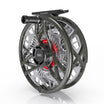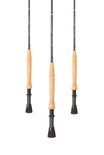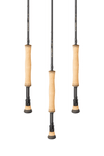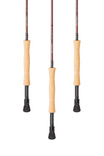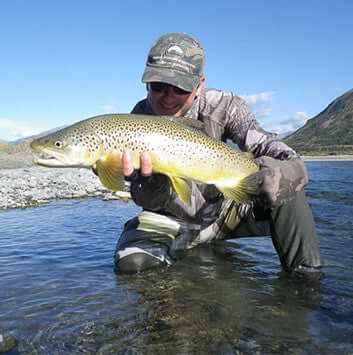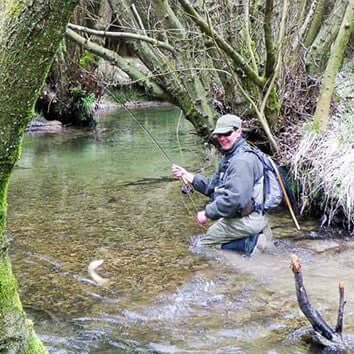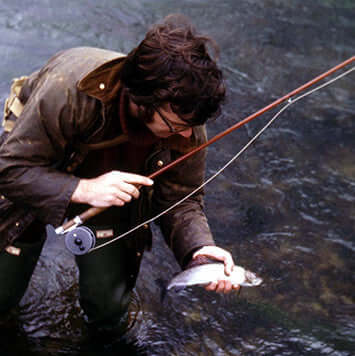Chasing big brown trout in New Zealand
Can you remember what you were doing on this day exactly twelve months ago? Chances are, unless it was something incredibly special, the passing of 366 days will have blurred your memory or even obliterated it altogether. I can remember exactly where I was and exactly what I was doing. I was enjoying a pint of ice cold Stella Artois in a bar in “departures” at Manchester Airport. I was waiting for a flight that would propel me towards a dream I had held for over thirty years. It was my fiftieth birthday present to myself and I was (finally) going to New Zealand! First of all it’s a bloody long way, so be prepared for a numb bum and a lengthy period without sleep (I can’t sleep on planes…just the way it is).

Truth is I was far too excited to sleep anyway and I watched crap movies and played computer games while slurping copious quantities of free beer all the way from Manchester to Hong Kong, Hong Kong to Sydney, and Sydney to Auckland. I had a range of gear with me, all of it biased towards river fishing. If anyone was taking me lake fishing or sea fishing, they would have to lend me the necessary tackle. I’d been warned about the size of some of the fish and also the unforgiving winds that habitually blow across both islands (but South Island in particular). I had rods rated from #5 to a really stiff #7 and I placed all my faith in Sunray International lines to match, having used them almost exclusively for the preceding 12 months. My North Island adventures lasted about three weeks and trout-wise I had an absolute blast. Fishing primarily on three river systems and landing a great many fish. There are a number of rivers that I wish I had fished but just didn’t get around to for one reason or another, but what better excuse for a return visit sometime in the future?
One of the rivers I spent a good deal of time on was a big wide expanse of water, occasionally flat but more commonly punctuated with regular boulders the size of family saloon cars. A good venue for the Kiwi version of our ‘duo’ method. The twist was that the dry fly would usually be a size 6 beast of a fly and 6-8’ down there’d be a seriously heavy nymph on a seriously strong hook. Rigs like this are hugely awkward to cast, especially long-distance, but I’d already done my homework and practice and I knew the International line’s WF profile would cope. Another favourite river of mine was much much smaller, shallower and gin clear, rather like a carrier off the Test… The fish were huge and I regularly found myself staring upstream at fish closer to 20lbs that to 10! These are super spooky fish in such a Lilliputian environment and the matt, dull finish of the International line again proved its worth allowing me super stealthy presentation at ranges which didn’t send the fish bolting for cover. After downing rods for a while and playing a proper ‘tourist’ travelling around both Islands, I found myself once again piscatorially-inclined at the north end of the South Island.
It was by this time into February and prime Kiwi holiday season. While the rivers were in many cases quite remote, there were more anglers on the banks and the fish were super spooky. I don’t think I’ve ever had fishing as tricky as this anywhere in the world. A slow walk up the bank gazing into the crystal clear water desperately trying to spot the nigh-on invisible fish before they spotted me… spooking some, but sighting others that were still feeding… getting into position to make that one perfect cast… only to find that the seemingly flawless cast had not been quite as flawless as I’d imagined, and the first fish I’d seen in a kilometre or so was slinking away to hide. Maddening! Not quite as maddening as those ones which spooked before even a single cast had been made! Up against such well-educated fish in such clear water - oh yes, and almost continually fishing into the teeth of the fabled ‘nor-wester’ wind that springs up from nowhere - I was so glad to have the International line loaded onto all my reels. Here the combination of the profile and the dull matt finish were a Godsend.
I found that I could fish into the strong winds most of the time and turn over the requisite lengthy leaders and long tippets necessary to give me even a chance of a take. It was heart-stopping stuff. Just to have the chance of spotting and trying to catch these huge wild fish in such stunning surroundings was exactly what I’d been dreaming about for all those years. I had built New Zealand up into a mythical fly fishing Valhalla and it didn’t disappoint me in any way whatsoever. And so, today is 2 January 2017, exactly a year on from my departure date, and guess what? I’m dreaming about making a return visit to reacquaint myself with those favourite river systems and explore some of the ones I missed last time… Who knows, I may even leave on 2 January 2018…




